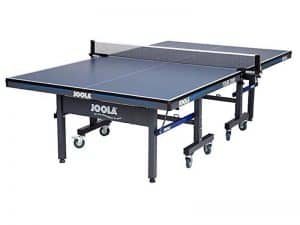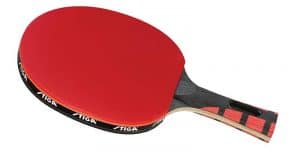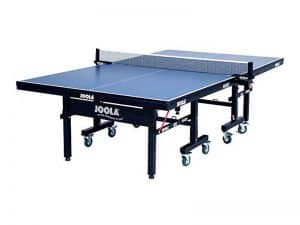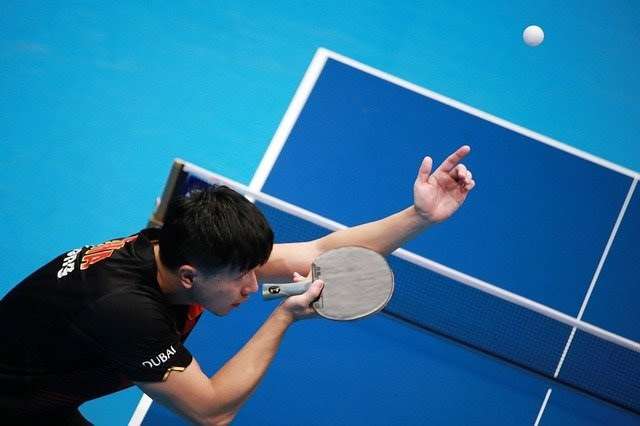How Many Calories Are Burned Playing Ping Pong?
- Kevin Finn
- Last updated
A 175 lb person playing ping pong burns around 333 calories in an hour. However, this doesn’t tell the full story. A burn of 333 calories equates to casual play, for competitive training and matches, I estimate 417 calories is a more accurate figure.
In this article, I go into detail as to why most ping pong calorie-burn calculators are inaccurate, and how you can adjust the formula to give you a more realistic estimate. Without any further ado, let’s dive in!
Table of Contents
How Many Calories Do You Burn Playing Ping Pong Per Hour?
An average person burns around 333 calories in 1 hour playing table tennis (175 lb player), but how did I arrive at that figure I hear you ask? Simple. I used the following equation:
(MET x 3.5 x (body weight in kilograms) / 200) x 60
With my figures added, here is how the calculation looks: (4 x 3.5 x 79.4 / 200) x 60
If you want to obtain your calorie burn per minute, just omit the 60 at the end of the formula!
You’re probably unsure what METS are, so let me enlighten you. Exercise physiologists assign a MET score (stands for “metabolic equivalent”) for physical activities to estimate calorie burn. The higher the MET score, the more calories are burned.
Yet while this calculation helps to provide a rough estimate for calorie burn, it is wildly inaccurate most of the time.
The Issue With Ping Pong’s MET Score
It is vital MET scores are accurate as they shape the final calorie estimate. The MET score for table tennis is 4.0. For context, this is the same score they assign to a task like hand-washing clothes or sweeping your garage… I think we can all agree this is an underestimate.
With most other sports, they make distinctions between casual/amateur play and competitive matches. See the table below for examples:
| Code | METs | Sport |
| 15030 | 5.5 | badminton, social singles and doubles, general |
| 15020 | 7.0 | badminton, competitive (Taylor Code 450) |
| 15500 | 6.0 | Paddleball (pickleball), casual, general (Taylor Code 460) |
| 15490 | 10.0 | Paddleball (pickleball), competitive |
| 15660 | 4.0 | table tennis, ping pong (Taylor Code 410) |
Notice they fail to give a category for competitive table tennis.
Herein lies the problem: People who don’t understand the sport simply assign a MET value of 4.0 to table tennis and use that for the calculation of the number of calories burned when playing table tennis.
The truth is, the modality matters quite a bit! A competitive match between table tennis players who take the sport seriously will burn far more calories than a casual game of “ping pong” between friends.
For example, recent data taken from table tennis players who had at least two years of competitive experience (and who train at least twice per week) shows an average heart rate of 142.69 with a peak heart rate of 167.26 during competitive matches.
Furthermore, there are training techniques and drills that table tennis players commonly use that can burn SIGNIFICANTLY more calories than a typical match.
Read More: 10 Awesome Benefits of Table Tennis
Adjusting the MET Score
For casual players, a MET score of 4 seems reasonable. However, if you’re playing at a higher level, you should consider upping the MET score to match the level it merits.
A good way to do this is to take the MET score of another sport that you estimate burns a similar amount of calories.
For competitive play, I feel a MET score of 5 is reasonable. General skateboarding has the same score and cricket is 4.8. Of course, you should also adjust the figure depending on your style of play and if you are training. Multiball drills are often far more taxing than regular matches, I’d estimate a MET score of 6-8 for intense drills.
In any case, if we use a MET score of 5 for the same calculation, this gives us a 417-calorie burn.
Total vs. Additional Calories Burned When Playing Ping Pong
While adjusting your MET score to the calorie calculation brings you closer to the actual number of calories burned, it’s still not perfect.
Something you should consider is the total calories burned relative to additional calories burned.
You are always burning calories, even when you are idle. This is known as your resting metabolic rate. Therefore, you might want to consider the difference between your resting calories burned and the amount you burn while playing table tennis. This is easy to compare as the MET value is the ratio of energy expenditure at rest relative to exercise. A MET of 1 is your idle expenditure, and if we take the MET score of 5 for competitive table tennis, we know playing table tennis consumes 5 times more calories than sitting and doing nothing.
Unfortunately, this is still not perfect. This is because your metabolism will compensate for calories burned through exercise by reducing other components of energy expenditure afterward.
So while you may think you burned 600 calories in that spin class, components of your metabolism, such as “non-exercise activity thermogenesis” (NEAT), often go DOWN for the remainder of the day. Therefore, in reality, your rate of energy burn is less than you might think.
Why You May Want to Reconsider Tracking Calorie Burn From Ping Pong and Other Forms of Exercise
I hope you can see now how complicated it can be to accurately calculate the number of calories burned while playing ping pong. Perhaps you think you can beat the system, though…
Maybe you picked up one of those fancy wearable activity trackers that factor in your body weight, heart rate, and step count.
Unfortunately, even though these wearable devices have improved in recent years, they’re still not all that accurate. Recent studies have shown that even some of the more popular name-brand wearables can be off in their group-level calorie burn estimates by more than 50%.
And even if the calorie burn estimates were accurate, there is a potentially deeper issue at play…
In my 10+ years of training people online to lose weight and get fit sustainably, one of the most common issues I’ve seen is a BROKEN relationship between exercise and food.
Too often, exercise is used as a form of punishment: A binge the night before is “paid for” with an extra intense exercise session the next day. A big holiday meal is “earned” by attempting to burn an extra 800 calories beforehand with a big workout.
This “burn it off” mentality creates a vicious cycle where an unhealthy relationship with both food and exercise can begin to develop.
Here’s How to Actually Lose Weight With Ping Pong and Table Tennis
If you want to use table tennis as a tool to assist with weight loss, here is what I recommend:
First and foremost, remember that weight loss only occurs when a calorie deficit is achieved, and the most direct way to accomplish that is by improving the quality of your diet. There’s a lot of wisdom to the phrase “You can’t outrun a bad diet!”
A good place to start is to begin consuming 2-4 protein-focused meals per day with an emphasis on whole food sources with minimal processing. Round those meals out with plenty of fruits and vegetables (around 5 or more servings per day is a good basic target).
From there, you can monitor your body weight and begin to dial things in further as needed.
Next, you should consider tracking your daily step count rather than attempting to figure out the number of calories burned during isolated exercise sessions. This will be more accurate and will better reflect your global activity levels throughout the day.
You should also perform 2-4 resistance training workouts per week to send strong signals to your body to burn FAT and keep (or even build) muscle. This will give you that lean, “toned” and athletic look that so many of us are after!
Finally, instead of adding traditional forms of cardio, engage in fun, low-impact exercise that can be used to keep overall activity levels up. And for this, table tennis fits the bill perfectly!
Read More: Table Tennis Warm-Ups You Should Do Before Every Game
Conclusion
Unfortunately, working out the number of calories you burn while playing ping pong can be a little difficult. If you’re a beginner, you can use the following equation to work out your hourly calorie burn: (4 x 3.5 x (bodyweight in kg) / 200) x 60. However, if you play at a higher level, you’ll need to adjust the MET score of 4 to a more reasonable figure.
Looking at similarly taxing sports, I estimate a MET score of 5 is more accurate. However, if you’re doing intense training drills the score will be much higher, 6-8 is my MET estimate.
Hopefully, you found all of this information useful. I tried to provide extra context and valuable advice. There’s nothing wrong with being curious about your energy expenditure, but you should also be informed about what to do with that information!
It’s the difference between knowledge and wisdom.
So use this information well, and make sure you keep coming back to Ping Pong Ruler to continue upping your table tennis IQ!
If you enjoyed this article, I recommend giving our write-up on pickleball calorie burn a read as well.
Frequently Asked Questions
Does Playing Ping Pong Burn Calories?
While ping pong doesn’t burn anywhere close to the amount of calories as more intense racket sports such as tennis and badminton, it’s still a great calorie burner. One of the reasons is that you can play the sport for much longer without getting tired.
How Many Calories Does 30 Minutes of Table Tennis Burn?
A 175 lb player can expect to burn around 166 calories with 30 minutes of play. That’s around 125 more calories than if they were idle. Of course, the calories burned playing competitive table tennis or performing intense drills are much higher.
How Do the Calories Burned Playing Ping Pong Compare With Other Sports?
Table tennis calorie burn is less than most sports. Casual table tennis has a MET score of 4, meaning it burns 4 times as many calories as at rest. In comparison, tennis has a score of 8, badminton is 7, and soccer is 10.
Is Ping Pong Good for Weight Loss?
Ping pong is an excellent tool for weight loss for one reason above all others — it’s fun! This means unlike that treadmill collecting dust in the corner of your guest bedroom; you’ll actually find yourself looking forward to playing.
It’s the perfect way to stay active & burn a few extra calories while having a blast!
Is Ping Pong a Good Workout?
Basement-style ping pong is an excellent way to increase your heart rate and stay active — it’s roughly equivalent to brisk walking. As your skills increase, however, ping pong turns more and more into a full-body workout that can do wonders for both your physical and mental health!
Is Table Tennis a Full-Body Workout?
Table tennis is a full-body workout that engages all the major muscle groups of the lower body, the core, and the upper body as well. In fact, it’s so “full body” that it even exercises your MIND! This makes it a superb workout for older people as mental alertness declines with age.
Studies have shown that table tennis can be a powerful strategy to prevent cognitive decline and dementia in the elderly.
Which Muscles Are Used in Table Tennis?
Table tennis engages nearly all of the body’s major muscle groups. It actively works all the major muscles of the lower body, including the quadriceps, hamstrings, and particularly the adductors and abductors of the hips and thighs. As for the upper body, you engage the pectorals, upper back muscles, deltoids, & more.
Is Table Tennis Considered Cardio?
Yes, table tennis is an excellent form of cardio. Because of the intermittent nature of the game, it is most similar to interval training. Research gathered at high-level table tennis tournaments reports an average heart rate of 142.69 during matches with a work-to-rest ratio of around 1:2-1:5.

Kevin Finn
Kevin Finn is the owner and creator of Peak Performance Table Tennis. He helps both casual and competitive athletes improve their performance and play pain-free with custom online workouts, nutrition plans, and consultations. Visit PeakPerformanceTableTennis.com to download a free chapter of his best-selling book!
-
This author does not have any more posts.
Popular Products
Join our email list for exclusive reviews & the latest Ping Pong News
Sign up to our newsletter and stay up-to-date with the latest news in the ping pong world, and be the first to read our new product reviews. We promise, no spam





















